DRAG racers commit plenty to their chosen sport. The costs are monumental, the time never ending, the stresses on family life onerous, and occasionally, the adrenalin-pumping risk which keeps them coming back can be life threatening.
This article was first published in Street Machine’s Hot Rod magazine #13, 2014
Quietly spoken, always smiling, Victorian drag racing pioneer Jim Walton met all those costs, and paid the price.
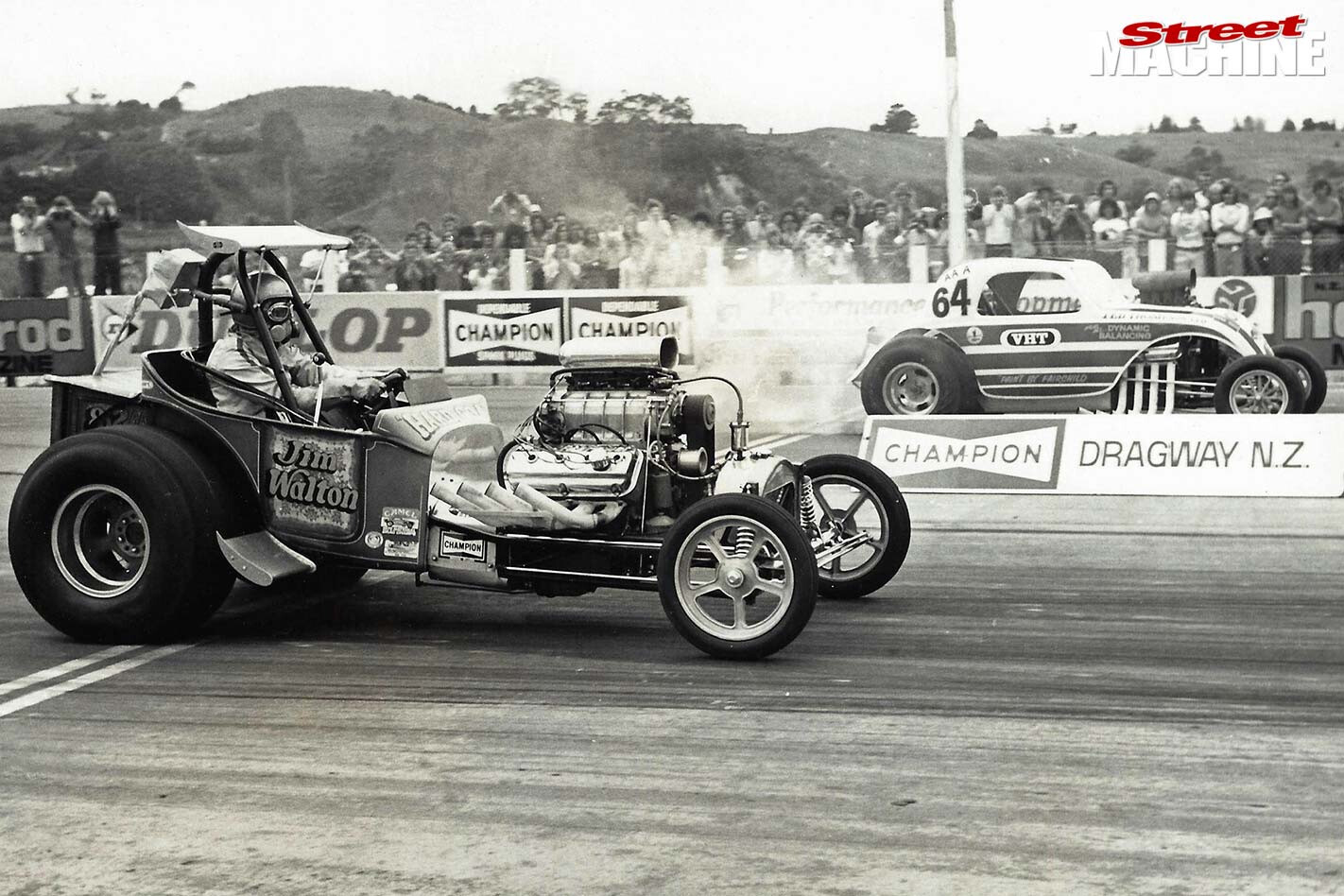
Jim still sees his days of racing in New Zealand as amongst the best of racing memories, usually competing against local Peter Lodge’s blown Hemi/Fiat
It was Saturday, January 30, 1982. The event was the season opener at Calder Park Raceway in Melbourne, and Walton in his Coca-Cola-sponsored Monza funny car was in a race against the funny car of Barry Bowling.
Jim’s crash at the end of Calder’s braking area in January ’82
“Everything was fine on the run, but when I pulled the chutes I didn’t feel the familiar thump as they blossomed, and I made the mistake of going for the chutes a second time,” Jim recalls of the worst day in his life. “I should have been pulling hard on the brakes at that stage and all of a sudden I was approaching the armco at a fairly rapid rate.
“I knew the armco took a hard turn to the right but I thought I’d be able to get around the corner and even if I didn’t I’d just bounce off it. But in those days the armco wasn’t embedded very far into the ground – the posts were only buried about 18 inches into the sand – and it collapsed and I barrel-rolled along the top of the armco. It cut the car in half and both my legs were left dangling out of what was left of the roll cage.
“The back half came to rest upside down with my left foot sitting up under my face. I knew then something was drastically wrong. I did a body check and most of my parts worked except for my left leg from the thigh down and I knew I was in trouble.
When rescuers arrived at the crash scene at the end of Calder’s braking area in January 1982 they found a shattered race car and a shattered Jim Walton. The Monza was broken in half and Jim’s leg was broken in 32 places. Within weeks he was back at the race track; within months sitting in race cars and within 18 months he was planning his return to competition
I was rushed off to hospital and the leg was broken in 32 places. They were getting ready to amputate and the psychology people were all over me preparing me for it. Then two weeks after the incident this doctor named David Young came in with a little tool box of nuts and bolts and explained how he was going to save my leg without taking it off. He assured me in years to come the leg would be about half an inch shorter than the right but I wouldn’t have a limp. Here I am all these years later and it’s still doing fine.”
The surgery was a world first medical breakthrough. Doctor Young was delighted at the opportunity as the five-layer firesuit had acted like a post-pack which held everything in approximate position – even while the contents were badly broken, with little tissue damage.
Young’s plan involved drilling holes into each bone section to hold threaded stainless steel studs. These studs extended to an external frame and held everything in place until all the breaks had reset. Jim’s wife Elaine, as a former nurse, was able to dress each of the pin sites to keep out infection.
Thirteen operations and many bone grafts later, Jim was back on his feet and starting to contemplate racing again.
Even before that, at the 1982 Nationals in Adelaide, with Jim still in a leg brace, Graeme Cowin sat him in his funny car when they warmed up in the pits.
Jim knew then he needed to get back into racing.
With 32 breaks in his left leg, Jim was told he’d lose it after taking out the armco in the Calder breaking area, but world breakthrough surgery stabilised all the pieces so it could reset. Here, six weeks after the accident, Jim tells the crowd at Calder – and track manager Stan Kofoed – what it was like
“Graeme was very supportive, not just of me but of a lot of racers. He gave me the drive to go back to racing. He sold me an ex-Jim Dunn Dodge Omni at a bargain basement price and I could drop my old engine into it. I could tell you some good stories about Graeme lending me parts over the years.”
After dispensing with the iron 392s Jim graduated to alloy blocks and more modern technology
Jim could also count himself lucky in having a very supportive and committed wife, Elaine. She understood his needs and even after the accident was happy he wanted to go racing again.
“If I said to her I wanted to go nitro funny car racing again she’d be right behind me, even now,” Jim says. “She misses it, and probably misses the
racing more than I do. She misses the social aspect, the camaraderie, the bond you have with the other racers.”
But after the accident, the recuperation and the medical care, Jim didn’t go back to racing without personal doubts.
“It’s like being kicked off a horse; the only way to beat the fear is to get back on the horse,” Jim says. “I had to do it just so I would know whether I
could do it again. It was my life. It’s who I am. It’s part of your DNA; it determines whether you’re an old nitro drag racer.”
“Coca-Cola was great. They wanted me to keep racing, but when I bought that Dodge from Graeme I wasn’t ready for a full time commitment to another sponsor. I just wanted to do it at my own pace. I wasn’t sure whether I could do it again because my leg was still pretty fragile.”
This classic image was shot by Phil Pullem for Australian Hot Rodding Review at Parafield Airport in South Oz. The flight controller was a fake, with modified ping pong paddles standing in for the real thing
This was light years from where it all began. Jim was like so many young drag racers when he first started in the mid-60s, racing on the street in an FJ Holden.
“You start tinkering with the FJ,” he says, “and one day it becomes too dangerous to drive on the street anymore so you put it on the drag strip. In those days you could start out like that.
“I was really hooked on the sport. You picked up magazines, like Popular Hot Rodding, and there would be a picture of ‘Wild Willie’ Borsch in his fuel
altered, going sideways with smoke coming off the tyres and one arm hanging onto the body, and I thought ‘maybe I could do this.’”
At the wheel of his FJ Holden in 1969, the launching pad for many a great racer’s career. In Jim’s case, the progression from grey motor-powered Humpy to a blown altered was startlingly quick
Jim got talking to Ian Splatt from Dragway Engineering, who was about to start work on an altered that would one day become the famed Bounty Hunter. It was to be unblown and on nitro; Jim had acquired a 392 Hemi and was going blown with nitro.
The shape of the frame holding his shattered left leg together is visible under his trouser leg, but within months of nearly losing the leg Jim Walton was back in the seat of Graeme Cowin’s Funny Car at the Nationals in Adelaide
“We decided to give it a go together, building our cars side by side in his workshops. They were just mild steel, with three-point cages.”
For about two years it seemed no race meeting in Adelaide was complete without Jim meeting Ian Splatt’s Bounty Hunter in a best of three match race. Things didn’t always go to plan though; Jim surveys the remains of his blower after a backfire
In July 1972 Jim trailered it across to Adelaide for its debut, running a best of a 10.44. It wasn’t setting any records, just yet, but it was light years
from a 14.9 second grey-motored FJ and it hooked him to the quarter mile – and nitro fuel – for the rest of his days.
“I was just so excited,” Jim recalls. “I remembered having read some American racer’s comments that when driving a car like this you never lift off
completely: never blink, never lift. The car bounced from back wheel to back wheel. Boy, was it exciting.
“Over the years I’ve come to the realisation when you’re driving these cars you’re not a human being, with fears and loves and the rest, you’re a part of the car. After that first run, at any meet, no matter how long you’ve been racing, the adrenaline’s pumping so hard that you could race that car and work on it all night long for a month.
“The thing I take pride in most is we were the pioneers. All we had to go on – and this includes the likes of Splatty and the other guys of the day – was what we read in American magazines, and they never said anything about wall thicknesses in roll cages or tyre pressures or whatever. We raced without gloves in single layer firesuits, with three-point cages too thin in the gauge, with single wall headers and tin rocker cover leaking oil all over them.
They were fantastic, exciting days.
“I don’t think I could even imagine getting into one of those things now. It had a 100-inch wheelbase, direct drive; the skinny tyres were spinning the full quarter mile because we didn’t have the benefit of slipping clutches. You just revved it up and dumped the clutch; 198mph and the tyres still
spinning, but that was how we got down the track.
“If you put too big a tyre on the car it wouldn’t work because it just bogged down the motor. It was a standard stroke old 392 iron Hemi motor, with a standard 6/71 blower off a six cylinder diesel truck. That car was so exciting and so much fun and we got paid appearance money to run it. We’d go to Adelaide and (manager) Bill Pickett would give Splatty and me money to put on a show.
“I keep on saying drag racing is different to any other motorsport. It’s not just cars in a procession. It’s a circus. Every few minutes there’s a
different sort of car on the start line, or something capable of acceleration, whether it’s a guy on roller skates with a hydrogen peroxide rocket on his
back or jet cars or wheelstanders, it’s all part of the scene. The sport’s gone away from that a bit but it may be what’s going to save the sport if we
can bring that circus element back.”
As a funny car racer Jim Walton won the Nationals in 1979, 1980, 1985 and 1989; the ADR Series Grand Finals in 1979, 1980, 1981, 1983 and the Australian Funny Car Championships in 1979, 1980, 1981 and 1983
Walton ran the fuel altered for four years, the highlight of which was going to New Zealand, on three separate occasions, where he broke the New Zealand land speed record.
When the promoters said get rid of your fuel altereds, we want funny cars, Jim went into partnership with Victorian top fuel veteran Graham Hussey in 1976 to field a low slung Mustang called Canned Heat
“That was an accidental thing,” Jim says. “It had been set at 192mph on some beach somewhere, and ours was purely unofficial as we didn’t do it with passes in opposite directions and all that, but it was pretty cool.
“At one time I had some braking problems. I had nitro pouring into my face because I’d cracked one of the top lines, but I had to beat this guy, Peter
Lodge. If you go onto YouTube and search Jim Walton versus Peter Lodge you can see the run. In the braking area I had to put the car sideways because I knew I was running out of room. I went sliding off up this hill, with quite a steep gradient, and to this day I believe there’s a little signpost up there saying ‘Walton’s Mountain’. Those memories are just indelible.”
Jim was one of the feature attractions at the 1988 Nationals at the new Willowbank Raceway
But Walton’s time in altereds was rapidly running out. CID manager Dave Andrew rang one day and said, “Okay guys, this is how it is, we want funny cars.
The latest thing in America is funny cars so you all have got to get rid of your nitro altereds and build or buy or borrow and get funny cars going.”
That was 1976 and shortly after Jim had entered a partnership with Top Fuel racer Graham Hussey in a low slung Mustang funny car called Canned Heat – an ex-Larry Fullerton car from the US, with a 417 Donovan sitting in a new chassis.
Jim in the ex-Gary Densham Monza at the 1979 Grand Final at Castlereagh
“That was a lot of fun,” Jim recalls. “It didn’t have a big lifespan but it did become the first Australian car to go 200mph in Victoria, and that pissed
off Larry Ormsby and others because we’d beaten them to it. I couldn’t stage it real well because the roof was so low I couldn’t see the top lights, so we got the jigsaw out and cut a sunroof in it.
“In those days we didn’t really know what we were doing and we were kind of making it up as we went along. If any of those cars had crashed at 190mph it would have been all over red rover and we would have been going to funerals.
“I never saw myself as being a daredevil. It was one of those things you just got used to. When you got in the car you weren’t thinking about your own safety, you just became an integral part of the car, like the wheels or any other bit. You just have the responsibility to get that car from A to B. Any race car driver can relate.”
Jim accepts his trophy from ANDRA National Director, Dennis Syrmis
Jim then bought an ex-Gary Densham Monza funny car in 1978, which was to become one of the most successful funny cars in Australian drag racing history.
Rescue crew and fellow racers rush to Jim’s aid after he blew the top off the motor and the body off the car at Heathcote in 1987. Once again, it wasn’t long before Jim was back on the horse
“We worked hard and were lucky to get Coca-Cola to sponsor us,” Jim recalls. “We won so many championships and events with that car. For some reason we could take it to any goat track and it would hook up. That car was so lucky; it just got us in the winner’s circle so many times.”
Jim’s arch rival for funny car supremacy was one of his best mates, Graeme Cowin. The pair regularly loaned each other bits to stay racing. Here they battle it out at Heathcote in 1980
Jim would go on to drive the Warlord Pontiac for Steve Brown in 1985 and ’86, then an ex-Gary Densham Dodge and an Australian Airlines Pontiac Firebird up until 1989, the latter tied to financial high flyer Alan Burlock.
Then, after winning the 1989 Nationals, things changed for Jim and he quit racing.
The Coca-Cola sponsored Monza was Jim’s most successful car, and the ride that would take him to his darkest hour
“To win a major event is an unbelievable feeling. To win a championship event, to win a Nationals after all the blood sweat and tears and the road trips and wheels falling off trailers and breaking crankshafts in tow vehicles, is fantastic. It makes it all worthwhile. But the sport was going through some changes and I got to a stage where I wasn’t enjoying it as much as I should have.
“The work effort that goes into the preparation of a car and also trying to run a business and keep a family intact is very demanding, especially when
you’re doing it on a bit of a budget. You’d work on the business until 6pm then take that hat off and work on the race car until midnight, and that was almost every day. I’d always said if I stopped enjoying it, I’d get out.
“I do miss the sport and I love the fact I can walk in and out of race tracks and connect with old racers. I made mates in the sport in the 1960s I still
have day-to-day contact with. It means a lot to an old bloke like me. I guess all I can say is drag racing has been in my DNA since I was 18 years of age and it’s been a wonderful thing. It’s a wonderful sport.”
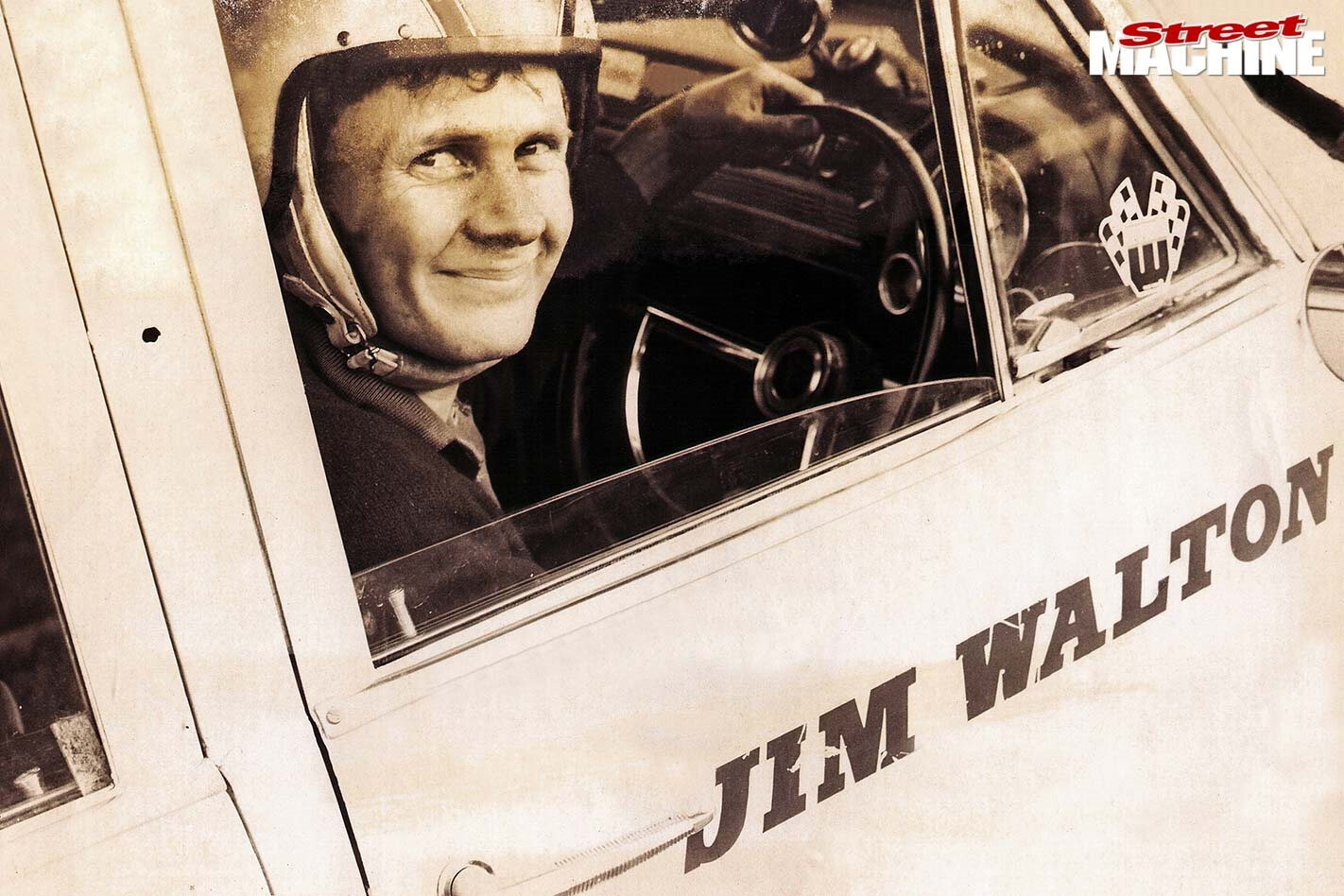
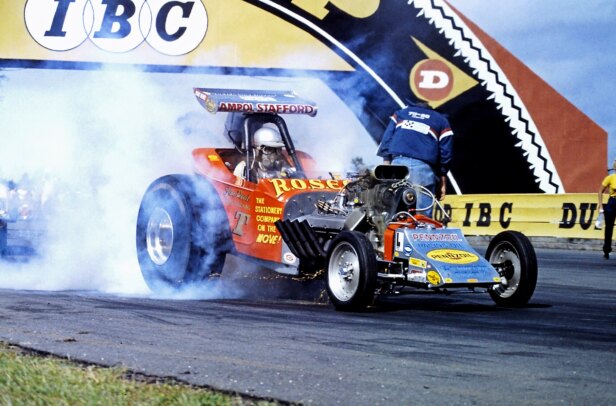
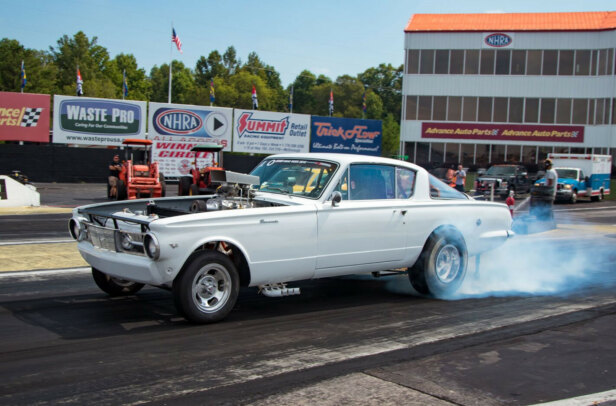
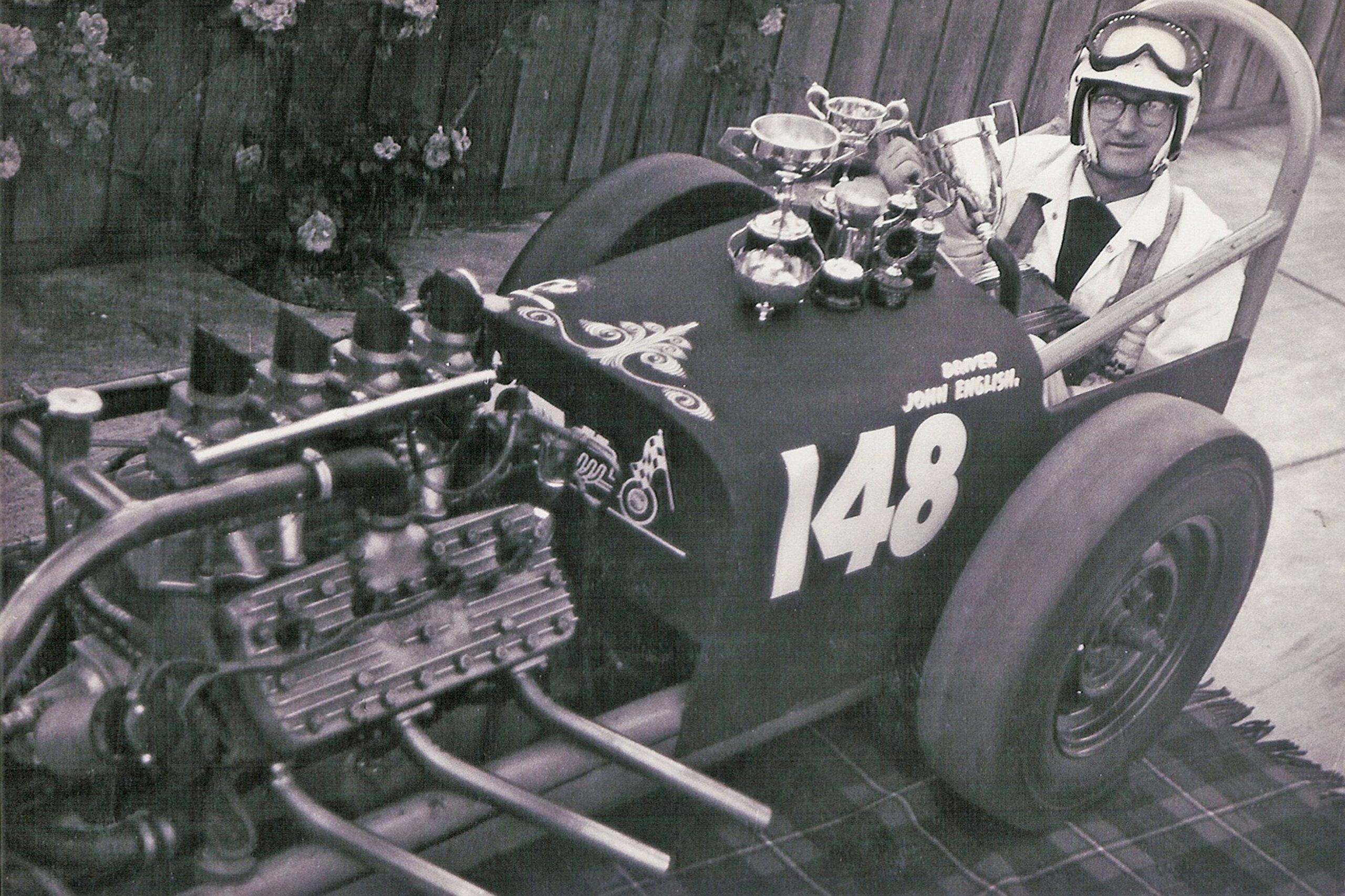
Comments